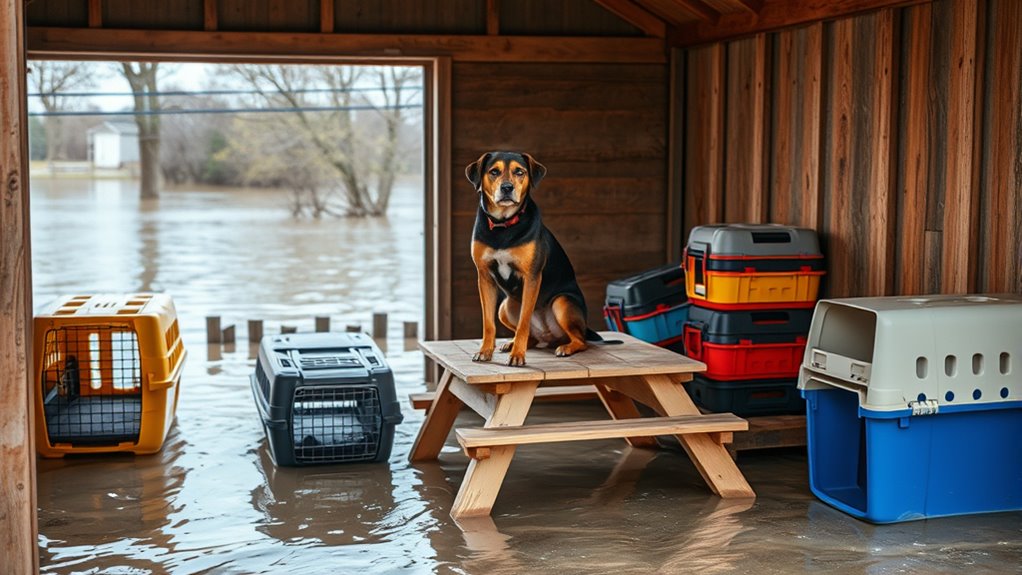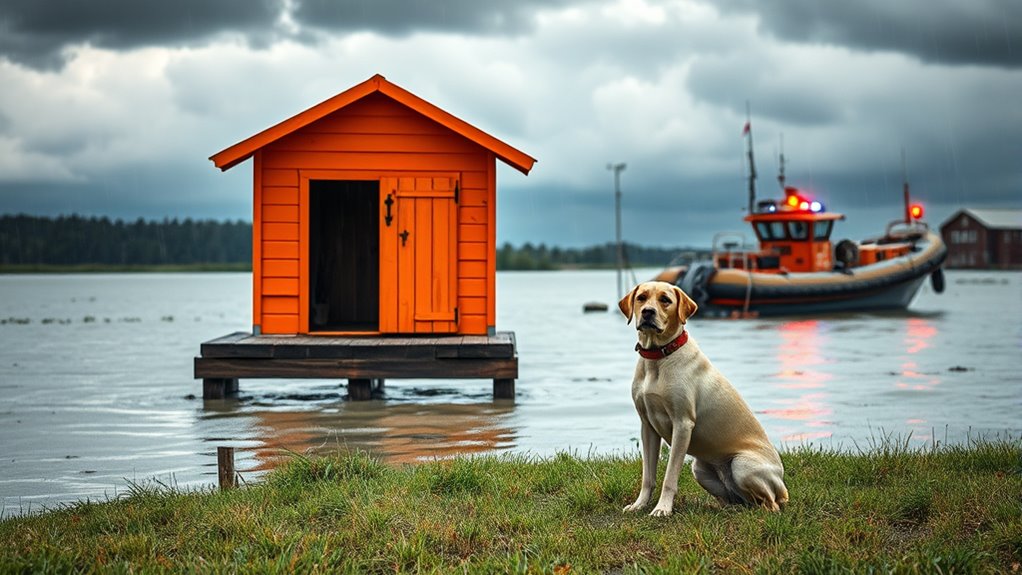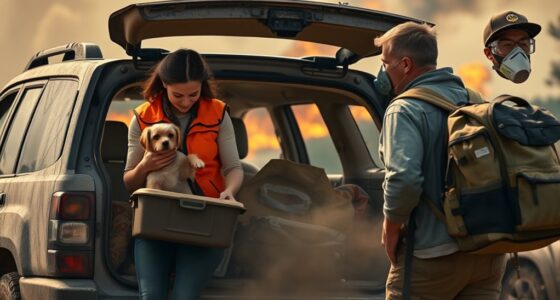To keep your pets safe during floods, prepare by securing their supplies in leak-proof containers and ensuring their identification is up-to-date. Familiarize them with carriers or crates to reduce stress, and plan quick evacuation routes to higher ground or pet-friendly shelters. Elevate bedding, food, and water bowls to keep them dry. Act swiftly in emergencies, calmly secure your pets, and stay prepared. Continue to explore these steps for extensive flood safety tips for your animals.
Key Takeaways
- Store pet supplies, including food, water, and medications, in waterproof containers and elevate them above flood levels.
- Use collars with updated ID tags and microchips to ensure pets can be identified if separated during a flood.
- Prepare a designated safe area within your home, elevated and away from floodwaters, to keep pets secure.
- Practice evacuation procedures regularly, including loading pets into carriers calmly and efficiently.
- Know the location of nearby pet-friendly shelters and have a quick-access emergency kit ready for rapid evacuation.

Are you prepared to keep your pets safe during a flood? When disaster strikes, ensuring pet safety becomes a top priority. Floodwaters can quickly turn dangerous, and without proper planning, your pets may become frightened, injured, or lost. That’s why having a clear plan and emergency supplies in place is essential to protect your furry friends and keep them above water. Preparing in advance allows you to act swiftly and confidently, reducing stress during an already chaotic situation.
Start by gathering emergency supplies specifically for your pets. These supplies should include enough food and water to last at least three days, as floods can disrupt supply chains and access to stores. Don’t forget to pack a sturdy, leak-proof container for water and a supply of familiar, easy-to-digest pet food. Additionally, include a first-aid kit tailored for animals, with bandages, antiseptic wipes, and any medications your pets need regularly. Having these supplies ready means you won’t waste precious time searching for essentials when minutes count.
Keep your pets’ safety in mind by ensuring they wear proper identification at all times. Microchips, collars with tags, and updated contact information can help reunite you if your pet gets separated during the chaos. Make sure your pets are familiar with their carriers or crates ahead of time, so they’re comfortable in a confined space if evacuation becomes necessary. Practice loading them into their carriers calmly, so they don’t associate it with stress during a real emergency. This step can appreciably ease their anxiety and yours.
Create an evacuation plan tailored to your home and neighborhood. Know the safest routes to higher ground or designated shelters that accept pets. Keep a leash, harness, and any necessary supplies close by, so you can evacuate quickly without searching. Designate a safe area in your home where your pets can stay if flooding begins unexpectedly. Elevate their bedding, toys, and food bowls on higher ground to prevent water damage and contamination. These small measures can make a big difference in keeping your pets safe and comfortable during a flood.
Frequently Asked Questions
How Can I Evacuate My Pets Quickly During a Flood?
To evacuate your pets quickly during a flood, plan pet rescue strategies ahead of time. Keep a leash, carrier, and emergency kit ready nearby. Know your flood evacuation routes and practice them with your pets. Stay calm and act swiftly, guiding your animals along safe paths. Having a clear plan minimizes stress and guarantees you can evacuate efficiently, keeping your pets safe and above water during emergencies.
What Are the Best Waterproof Supplies for Pets?
Your pet’s safety depends on having the best waterproof supplies—these are your ultimate shield against floodwaters. Invest in waterproof pet gear like boots, jackets, and food containers to guarantee they stay dry and protected. For pet flood proofing, consider waterproof carriers and tarps to keep their living space dry. These supplies create a fortress that makes even the worst flood look like a minor drizzle, ensuring your pet stays safe and comfortable.
How Do I Find Pet-Friendly Flood Shelters?
To find pet-friendly flood shelters, start by checking your local shelter policies online or calling ahead to confirm they accept pets. Use pet identification methods like ID tags or microchips to make sure your animal’s safe if separated. Contact local animal control or rescue organizations for updated shelter information, and keep a list handy. Planning ahead guarantees you’ll know where to go if a flood threatens your area.
What Should I Include in a Pet Emergency Kit?
You should include essentials like pet first aid supplies, such as bandages and antiseptic wipes, and enough food and water for several days. Don’t forget a leash, a carrier, and your pet’s emergency contact info. Also, pack any medications your pet needs, along with recent photos for identification. These steps guarantee you’re prepared to handle emergencies and keep your pet safe during a flood.
How Can I Prevent My Pets From Panicking During a Flood?
To prevent your pets from panicking during a flood, stay calm yourself, as your dog behavior is influenced by your actions. Use pet calming techniques like gentle voice commands and familiar toys to soothe them. Keep them in a secure, familiar space and avoid sudden movements. Gradually introduce calming routines beforehand, so they feel safe and reassured, helping reduce their anxiety during the stressful situation.
Conclusion
Preparing for floods might seem overwhelming, but with a little planning, you can keep your pets safe and dry. Some worry it’s too much effort, but having a go-bag and emergency plan is quick to set up and can save your pet’s life. Remember, taking these steps now means you’ll be ready to protect your furry friends without panic when a flood hits. Your pets rely on you—be their safe haven.










